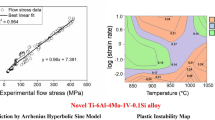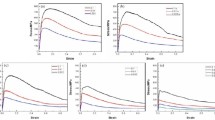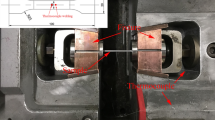Abstract
This paper developed high-temperature deformation constitutive models for a Ti6Al4V alloy using an empirical-based Arrhenius equation and an enhanced version of the authors’ physical-based EM + Avrami equations. The initial microstructure was a partially equiaxed α + β grain structure. A wide range of experimental data was obtained from hot compression of the Ti6Al4 V alloy at deformation temperatures ranging from 720 to 970 °C, and at strain rates varying from 0.01 to 10 s−1. The friction- and adiabatic-corrected flow curves were used to identify the parameter values of the constitutive models. Both models provided good overall accuracy of the flow stress. The generalized modified Arrhenius model was better at predicting the flow stress at lower strain rates. However, the model was inaccurate in predicting the peak strain. In contrast, the enhanced physical-based EM + Avrami model revealed very good accuracy at intermediate and high strain rates, but it was also better at predicting the peak strain. Blind sample tests revealed that the EM + Avrami maintained good predictions on new (unseen) data. Thus, the enhanced EM + Avrami model may be preferred over the Arrhenius model to predict the flow behavior of Ti6Al4V alloy during industrial forgings, when the initial microstructure is partially equiaxed.















Similar content being viewed by others
References
D. Banerjee and J.C. Williams, Perspectives on Titanium Science and Technology, Acta Mater, 2013, 61(3), p 844–879
M. Peters, J. Hempten, D. Banerjee, and J.C. Williams, Perspectives on Titanium Science and Technology, Acta Mater., 2013, 61, p 844–879
T. Seshacharyulu, S.C. Medeiros, W.G. Frazier, and Y.V.R.K. Prasad, Hot Working of Commercial Ti-6Al-4V with an Equiaxed α-β Microstructure: Materials Modeling Considerations, Mater. Sci. Eng. A, 2000, 284, p 184–194
R. Ding, Z.X. Guo, and A. Wilson, Microstructural Evolution of a Ti-6Al-4V Alloy During Thermomechanical Processing, Mater. Sci. Eng. A, 2002, 327, p 233–245
C.H. Park, K.-T. Park, D.H. Shin, and C.S. Lee, Microstructural Mechanisms During Dynamic Globularization of Ti-6Al-4V Alloy, Mater. Trans., 2008, 49, p 2196–2200
S.L. Semiatin and T.R. Bieler, The Effect of Alpha Platelet Thickness on Plastic Flow During Hot Working of TI-6Al-4V with a Transformed Microstructure, Acta Mater, 2001, 49, p 3565–3573
T. Seshacharyulu, S.C. Medeiros, W.G. Frazier, and Y.V.R.K. Prasad, Microstructural Mechanisms During Hot Working of Commercial Grade Ti-6Al-4V with Lamellar Starting Structure, Mater. Sci. Eng. A, 2002, 325, p 112–125
N. Bontcheva and G. Petzov, Microstructure Evolution During Metal Forming Processes, Comput. Mater. Sci., 2003, 28, p 563–573
H. Grass, C. Krempaszky, T. Reip, and E. Werner, 3-D Simulation of Hot Forming and Microstructure Evolution, Comput. Mater. Sci., 2003, 28, p 469–477
R.C. Picu and A. Majorell, Mechanical Behavior of Ti-6Al-4V at High and Moderate Temperatures—Part II: Constitutive Modeling, Mater. Sci. Eng. A, 2002, 326, p 306–316
J. Xiao, D.S. Li, X.Q. Li, and T.S. Deng, Constitutive Modeling and Microstructure Change of Ti-6Al-4V During the Hot Tensile Deformation, J. Alloy. Compd., 2012, 541, p 346–352
J. Lin and Y. Liu, A Set of Unified Constitutive Equations for Modelling Microstructure Evolution in Hot Deformation, J Mater. Proces. Technol., 2003, 143–144, p 281–285
L.X. Kong, P.D. Hodgson, and D.C. Collinson, Extrapolative Prediction of the Hot Strength of Austenitic Steels with a Combined Constitutive and ANN Model, J Mater. Proces. Technol., 2000, 102, p 84–89
S. Sajadifar and G. Yapici, High Temperature Flow Response Modeling of Ultra-Fine Grained Titanium, Metals, 2015, 5, p 1315–1327
J. Cai, F. Li, T. Liu, B. Chen, and M. He, Constitutive Equations for Elevated Temperature Flow Stress of Ti-6Al-4V Alloy Considering the Effect of Strain, Mater. Des., 2011, 32, p 1144–1151
J.K. Fan, H.C. Kou, M.J. Lai, B. Tang, H. Chang, and J.S. Li, Characterization of Hot Deformation Behavior of a New Near Beta Titanium Alloy: Ti-7333, Mater. Des., 2013, 49, p 945–952
Y.C. Lin, C.-Y. Zhao, M.-S. Chen, and D.-D. Chen, A Novel Constitutive Model for Hot Deformation Behaviors of Ti-6Al-4V Alloy Based on Probabilistic Method, App. Phy. A, 2016, 122, p 1–9
J. Luo, M. Li, X. Li, and Y. Shi, Constitutive Model for High Temperature Deformation of Titanium Alloys Using Internal State Variables, Mech. Mater., 2010, 42, p 157–165
X.G. Fan and H. Yang, Internal-State-Variable Based Self-Consistent Constitutive Modeling for hot Working of Two-Phase Titanium Alloys Coupling Microstructure Evolution, Int. J. Plast, 2011, 27, p 1833–1852
P.M. Souza, H. Beladi, R. Singh, B. Rolfe, and P.D. Hodgson, Constitutive Analysis of Hot Deformation Behavior of a Ti6Al4V Alloy Using Physical Based Model, Mater. Sci. Eng. A, 2015, 648, p 265–273
Y.C. Lin, Y.-C. Xia, X.-M. Chen, and M.-S. Chen, Constitutive Descriptions for Hot Compressed 2124-T851 Aluminum Alloy Over a Wide Range of Temperature and Strain Rate, Comput. Mater. Sci., 2010, 50, p 227–233
Y.C. Lin, M.-S. Chen, and J. Zhong, Numerical Simulation for Stress/Strain Distribution and Microstructural Evolution in 42CrMo Steel During Hot Upsetting Process, Comput. Mater. Sci., 2008, 43, p 1117–1122
R.L. Goetz and S.L. Semiatin, The Adiabatic Correction Factor for Deformation Heating During the Uniaxial Compression Test, J. Mater. Eng. Perform., 2001, 10, p 710–717
C. Zener and J. Hollomon, Effect of Strain Rate Upon Plastic Flow of Steel, J. App. Phys., 1944, 15, p 22–32
I. Sen and U. Ramamurty, High-Temperature (1023 K to 1273 K [750 °C to 1000 °C]) Plastic Deformation Behavior of B-Modified Ti-6Al-4V Alloys: Temperature and Strain Rate Effects, Metal. Mater. Trans. A, 2010, 41, p 2959–2969
S.I. Oh, S.L. Semiatin, and J.J. Jonas, An Analysis of the Isothermal Hot Compression Test, Mater Trans. A, 1992, 23, p 963–975
Q. Chao, P. Hodgson, and H. Beladi, Ultrafine grain Formation in a Ti-6Al-4V Alloy by Thermomechanical Processing of a Martensitic Microstructure, Metal. Mater. Trans. A, 2014, 45, p 2659–2671
N.-K. Park, J.-T. Yeom, and Y.-S. Na, Characterization of Deformation Stability in Hot Forging of Conventional Ti-6Al-4V Using Processing Maps, J. Mater. Proces. Technol., 2002, 130–131, p 540–545
D. Samantaray, S. Mandal, and A.K. Bhaduri, Constitutive Analysis to Predict High-Temperature Flow Stress in Modified 9Cr-1Mo (P91) Steel, Mater. & Des., 2010, 31, p 981–984
D. Samantaray, S. Mandal, and A.K. Bhaduri, A Comparative Study on Johnson Cook, Modified Zerilli-Armstrong and Arrhenius-type Constitutive Models to Predict Elevated Temperature Flow Behaviour in Modified 9Cr-1Mo Steel, Comput. Mater. Sci., 2009, 47, p 568–576
S. Mandal, V. Rakesh, P.V. Sivaprasad, S. Venugopal, and K.V. Kasiviswanathan, Constitutive Equations to Predict High Temperature Flow Stress in a Ti-Modified Austenitic Stainless Steel, Mater Sci. Engg. A, 2009, 500, p 114–121
P. Castany, F. Pettinari-Sturmel, J. Crestou, J. Douin, and A. Coujou, Experimental Study of Dislocation Mobility in a Ti-6Al-4V Alloy, Acta Mater., 2007, 55, p 6284–6291
S.H. Zahiri, C.H.J. Davies, and P.D. Hodgson, A Mechanical Approach to Quantify Dynamic Recrystallization in Polycrystalline Metals, Scripta Mater., 2005, 52, p 299–304
H. Mecking and U.F. Kocks, Kinetics of Flow and Strain-Hardening, Acta Metall., 1981, 29, p 1865–1875
Y. Estrin and H. Mecking, A Unified Phenomenological Description of Work Hardening and Creep Based on One-Parameter Models, Acta Metall., 1984, 32, p 57–70
Acknowledgments
The authors wish to acknowledge the Australian Research Council (FL0992361) and Bharat Forge Ltd., for the funding and support provided to carry out this research.
Author information
Authors and Affiliations
Corresponding author
Rights and permissions
About this article
Cite this article
Souza, P.M., Beladi, H., Singh, R.P. et al. An Analysis on the Constitutive Models for Forging of Ti6Al4V Alloy Considering the Softening Behavior. J. of Materi Eng and Perform 27, 3545–3558 (2018). https://doi.org/10.1007/s11665-018-3402-y
Received:
Revised:
Published:
Issue Date:
DOI: https://doi.org/10.1007/s11665-018-3402-y




